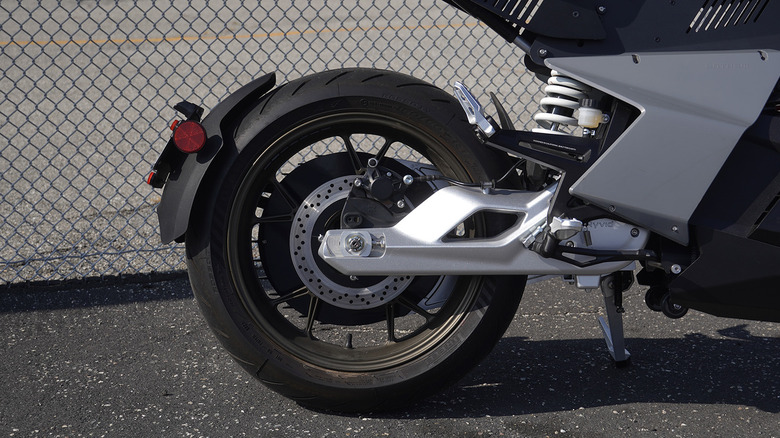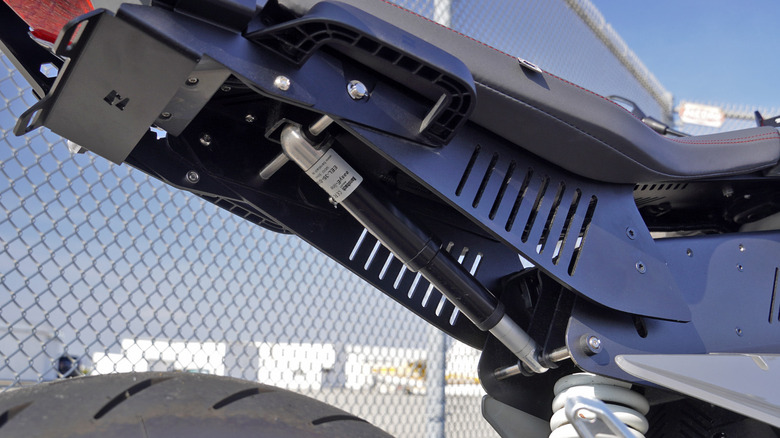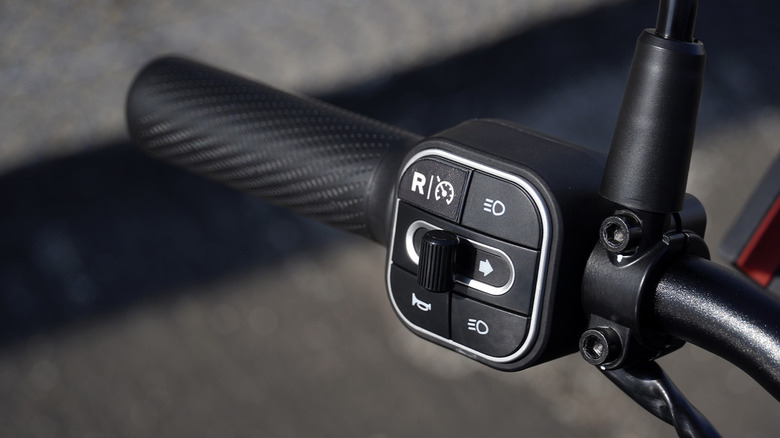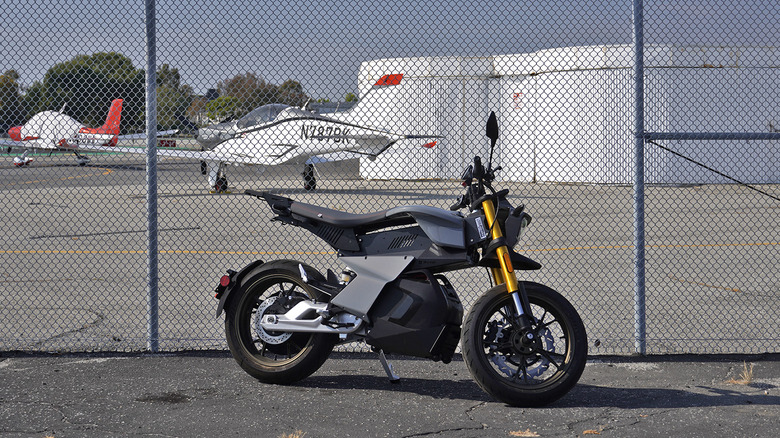2024 Ryvid Anthem Review: Almost The Perfect Commuter Bike
- An affordable step up from electric bicycles
- Lightweight and nimble for city riding
- Just enough power for commuting with ease
- Nifty details include a removable battery and adjustable seat height
- Range and power can't match ICE bikes
- A few features need additional refinement
- Questions about long-term reliability from a startup
By almost all accounts, the electric motorcycle industry faces a serious slump. Sales seem to dwindle with each passing month, so much so that Italy's industry leader Energica applied for bankruptcy in October of this year, after Cake did so in February. Here in the United States, Harley-Davidson reported just 99 Livewire units sold in Q3 of 2024, a far cry off the (obviously optimistic) projected sales of 100,000 units originally predicted for 2026. Zero Motorcycles abstains from sharing sales stats with the general public, but after speaking to multiple dealers over the past six months, I can report the picture looks less than rosy.
Amid recent trends in the larger EV market, the downturn might look less sudden than expected, too. Especially given that e-moto manufacturers initially prioritized range and power over all else, in the hopes of appealing to existing motorcycle enthusiasts, rather than catering to new converts. But big battery packs and big motors mean big and heavy bikes, not to mention expensive components, and so electric motorcycles typically end up costing far more than internal-combustion bikes with equivalent range and performance metrics.
Startup mentality for an electric motorcycle
But different companies jumping into the fray clearly hope to change that mindset. Can-Am's recently launched Pulse and Origin e-motorcycle models can barely hit triple-digits in range terms, and certainly not in miles per hour, but rather focus on nimble city commuting. Yet both still cost well into five figures, making for a dubious proposition (and don't ask about Can-Am's borderline hilarious projection of 95 million potential customers worldwide).
Meanwhile, from stage left enters a California startup called Ryvid and the Anthem, a simple bike that I recently spent a month testing in Los Angeles. With minimal range and power, the Anthem therefore weighs less than the competition by a fair margin, while adding nifty features including a removable battery and an adjustable seat. Most importantly, the $6,495 starting price seems right. So, is this finally the perfect electric motorcycle for commuters? Well, therein lies some rub.
Specs and stats for the Ryvid Anthem
Riding the Ryvid around West LA, seemingly the perfect setting, the Anthem's design certainly caught a few eyes. Futuristic lines perfectly split the gap between simple and functional, plus the gold forks lend a touch of class (even if Öhlins might want to have a quick chat). Ryvid claims the Anthem can manage 75 miles an hour and 75 miles of range, though the latter only in slower-speed urban environments. Push things up to a 55 mph cruise, however, and that number drops down to just 46 miles.
Clearly, then, an Anthem lacks some of the appeal that many motorcyclists prize for long cruises or, in my case, quick rips up to Malibu and the Angeles Crest Highway for hard-charging in the canyons. But the specs combine with thoughtful details that reveal a certain level of concerted research and development went into this electric two-wheeler.
Nifty details for a commuter bike
Most importantly, the electric motor mounts into the swingarm and the removable battery sits ahead of the foot pegs. Popping out that bowling-ball-sized contraption requires pulling a few levers, unplugging a high voltage line, and applying a bit of muscle to scoot the weight forward. The cells total up to 4.3 kilowatt-hours, but including a protective coat of armor, still weigh 87 pounds, so Ryvid includes little rollerblade wheels on the bottom to help shove the dense hunk of mass around.
The battery can charge via Level 1 or 2 plugs, and Ryvid's onboard IP even recognized my weak garage outlet, which most EVs and electric motorcycles don't even notice. Still, 75 miles of max range sounded dubious for anything more than shorter trips around town, so I kept the battery plugged in most of the time. I also kept the Anthem in "S" mode—presumably for Sport—over almost the entire period of the loan, after just my first spin around the block. Doing so eats into mileage, but I never planned to push the limit in the name of science, despite keeping an eye on the battery readout at all times.
Adjustable seat height for riders of all sizes
If the range and removable battery sound purposefully engineered for city riding, get a load of the adjustable seat, which at the push of a button can raise or lower to allow for a standover height range from 31 to 34 inches. The system uses an electronically controlled pushrod strut, and takes just a few seconds to go from the lowest setting to the highest (or vice versa). At 6'1" with long legs, though, I preferred somewhere right in the middle zone, not because that height let me straddle the seat easily but more importantly because Ryvid shaped the seat flat enough that raising or lowering the rear creates a substantial amount of slope.
That slope becomes less consequential while leaning off the bike, in fairness, but — especially for a commuter — a saddle shape that prevents you sliding fore and aft would help to improve one of the Anthem's key features. Not least because the pegs actually sit fairly far back for an upright bike, unlike on a supermotard or dirt bike with a similar seat design. Plus, I struggle to imagine actually riding the Anthem with a two-up passenger behind me, given the limited power output.
Acceleration tails off steeply
At full "throttle" in Eco mode, the Anthem barely pulls away from traffic at a stoplight: the rankings of fastest electric bikes are in no danger. Switching over to S induces much more pep into the response, allowing for a claimed 0-30 mph time of 1.1 seconds as the electric motor puts out 20 kilowatts—or what Ryvid calls 340 lb-ft of "initial torque" (whatever that means). In S, I got up to 65 and 70 mph quickly enough, but whether aero or purposeful de-rating affects pickup from there, acceleration certainly tails off steeply.
Pulling hard in S mode also eats into range quickly, though unlike most EVs and electric motorcycles, the Anthem's gauge cluster only features a battery percentage readout rather than a distance prediction. Though that lack of certainty rankled my range anxiety at first, I eventually learned to appreciate that a simple percentage requires less mental math while riding, similar to an old analog gas gauge on a classic car. And the gauge screen also shows amperage flow at all times, which creates a fun game of trying to max out efficiency.
Whipping around town
At one point in S mode, though, the screen froze up. Admittedly, I had a turn signal on, while pulling hard on the throttle and scooting the seat height upward—don't ask why–so perhaps I overwhelmed the computer. And yet, the Anthem supports Level 2 fast charging to allow for a claimed 80-percent top-up in half an hour, so theoretically the electrical system should easily cope with such an electrical load quite well.
Adjusting to the Anthem's power output in S mode, the saddle height, and footpegs took a few trips around the neighborhood. But I quickly discovered that zippy sprinting in S matches the spirit of the bike quite well, thanks to the perfect weight distribution and low-slung polar moment of inertia. The rear end rarely squats too much thanks to mounting the motor in the swingarm, and the lack of overall mass prevents too much nosedive. Meanwhile, I found myself shifting my hips around on the seat for most corners, then starting to slide my weight around on the pegs more while countersteering as I leaned over further to explore the nimble nature of such a simple bike.
Missed opportunities for unique features
On the other hand—quite literally—the brakes seemed to me like Ryvid's most obvious missed opportunity. Without a clutch to operate, the Anthem's left handlebar lacks a clutch lever. And yet, Ryvid decided to keep the rear brake controlled by my right foot. Why not switch over to hand operation? Sure, the single front brake disc works fine because the whole bike only weighs 313 pounds, but being able to better modulate wheelspin while leaned over might help to improve the transition from braking to throttle. Never doubt that every single time I swung a leg over that adjustable seat, I also grabbed an empty left hand full of no clutch lever...
A few other conceptual issues stood out, too, perhaps down to the Anthem's pricing or intentions of attracting more experienced (read: stubborn) motorcyclists. For example, the ability to swap in a new battery pack while charging up entirely transforms the potential use cases of the Anthem, yet the included charging cable cannot fit into the small storage cubby on the top of the "tank." At least an adaptor should fit in that little compartment, which also lacks weatherstripping or a seal for the lid and therefore noticeably rattles on all but the smoothest road surfaces.
The screen also angles sharply upward, creating serious glare that, when combined with my tinted helmet visor, essentially rendered all the readouts for powertrain temperatures, battery state of charge, and amperage flow illegible.
Reverse on a motorcycle works just alright
Another cool function, the ability to put the bike in reverse, helps with negotiating steep slopes—and yet, the Anthem lacks any ability to set the rear wheel into some kind of locked mode to park. With a gas bike, putting it into gear rather than neutral allows the transmission and engine to prevent it from rolling away. An equivalent way to hold the Anthem's rear tire–either when the kickstand goes down, or via a button–would be welcome.
If I owned a Ryvid and commuted to work, I might invest in a second battery to keep at the office, swapping out every day to reduce my electricity bill and keep my range topped up (after all, I simply needed to keep the Anthem in S at all times). But I would also probably roll the handlebars and controls upward, too. The switchgear and front brake lever all work simply and intuitively, but angle down toward the ground too steeply—at least on my tester.
A few more areas for improvement
Getting up to 90 miles an hour might help, too, though doing so might eat into range even more quickly. Still, the battery percentage readout seemed fairly predictable throughout my time with the Anthem, and I almost—almost—built up the courage to go for a long ride to Malibu, though definitely not the Angeles Crest, before Ryvid took the bike back. Oh well, maybe next time, and assuming Ryvid survives where other electric motorcycle startups failed to.
Some of my gripes and groans about the Anthem require just a simple fix, others might require a few tools and some time in the garage, and the rest probably dictate a full update from Ryvid. And yet, the Anthem edges so nearly to fulfilling every need for a perfect commuter motorcycle—which I still believe presents the perfect use case for electric motorcycles, in general.
2024 Ryvid Anthem Verdict
Ironing out those last finer details might require too much expenditure for Ryvid to amortize into long-term sales projections, though. And long-term reliability from such a new company also comes into play. My Anthem always started up and ran just fine, other than the one screen blip that corrected after a quick power cycle. But I also heard from a colleague that an Anthem bricked and left them stranded. Not ideal—then again, at least the Anthem isn't the kind of bike on which I'd likely end up too far out in the middle of nowhere.
Priced at $6,495 to start, with an optional power upgrade available for another grand that increases low-end torque by 30%, the Anthem still costs about half as much as either of the Can-Ams. A Livewire or Zero slots into an entirely different performance level, but the new entry-level XE from Zero due out next summer should sticker for the same figure. Given that the cost to run an Anthem borders on entirely negligible—no shredded tires, no oil changes, just plug in and barely notice a blip on the electrical bill—for now, Ryvid probably has the market for the most practically affordable commuter motorcycle comfortably cornered.












